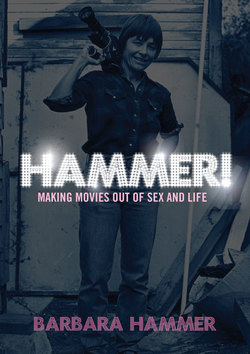Читать книгу HAMMER! - Barbara Hammer - Страница 9
На сайте Литреса книга снята с продажи.
ОглавлениеThe 70s were a glorious time of feminist ideals and lesbian bed-hopping.
At least, it was for me. I was lucky to come out with a group of self-identifying and self-determining lesbians. We were making a new culture with hairstyles, dress (and undress), and ways of walking and talking in the world. Everything was part of this new self-definition. There were parties, meetings, coffeehouses, bars, picnics, and, of course, potlucks. The circles were always expanding, and a friend today might become a lover tomorrow and an ex the following week. It was empowering, community forming, and, most of all, it was really good fun. Certainly, my life changed when I came out in 1970.
When I made love with a woman for the first time my entire worldview shifted. I was touching a body much like my own which heightened all my senses. In addition to the sensual pleasures, my social network completely changed; I was swept up with the energies and dreams of a feminist revolution. We could make a new world where everyone was equal. We believed it, and we tried our best to live it. After returning from a motorcycle trip through Africa with my first woman lover, I enrolled in film school and gathered a group of women to go to the country for a weekend of filming. Cris Saxton and I shot an hour’s length of film as I directed women to walk through fallen leaves, comb one another’s hair, trace circles with their fingers on each others’ bodies, and embrace.
In the editing room I looked at the footage of the nature rituals and yawned. This was not cinema. This was an exercise in relaxation. I got brutal and cut the lackadaisical footage to shreds, only keeping the core of each image that showed touching. The hour became two minutes. I asked Cris to film Poe Asher and myself pretending to make love (in all my filming of sexuality, it has never been documentary). I directed her to stroke us with the camera as if she were part of the sexual foreplay. I wanted an intimate cinema, not a cinema of distance that invited voyeurs. My favorite shot is when I asked Cris to wind the camera tight and set it on the ground between our bodies, and let it film by itself as we ran our hands from our bellies to our breasts. This was as close to showing the interior sensation of touch as I could imagine.
My final edit was four minutes long with 110 shots. Dyketactics (which I sometimes call a “lesbian commercial”) was scheduled to premiere at the university’s film finals, where all the students’ films were shown at the end of the semester. I had been the only woman of twelve students in my film production course. But here I was not only making a woman-centered film but also putting my own intimately depicted body on the screen. I wasn’t prepared for the response.
Professors always attend film finals and all of them were men. After the films were screened, a number of my professors ran up to me where I was standing in the back of the large auditorium. They were full of praise for the film. I was truly dumbfounded, but knew I was on to something big. I didn’t know it then but Dyketactics was the first lesbian-lovemaking film to be made by a lesbian.
I had passion. I had a cabin without electricity or running water. I had an old manual typewriter. On a dirt road above the South Fork of the Yuba River in Northern California with no one around for miles, I sat on the front porch every day and wrote for one month. I disciplined myself: I would not leave the typewriter until I had either worked for four hours or written four pages. Then, feeling light of heart and in good spirit, I took off for the river and explored my surroundings, much as I had explored in writing characters in love.
The 70s were a heady time for newly self-identified feminist women. Many of us were attracted to each other and didn’t hesitate to act on those passions. We were in and out of bed between protests, demonstrations, and art making. I thought this was an unusual period of time and that I should write about these encounters and experiences while they were fresh. I decided to create a fictionalized version of my very early lesbian loves, featuring an overzealous narrator. Looking back on it now, it strikes me as so 70s, so me! Here is part of the novella I call, “My Life as Henry Miller.”
